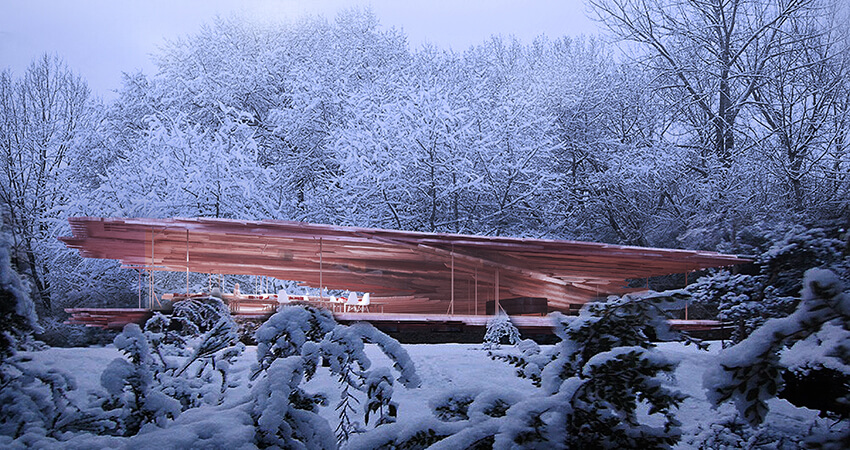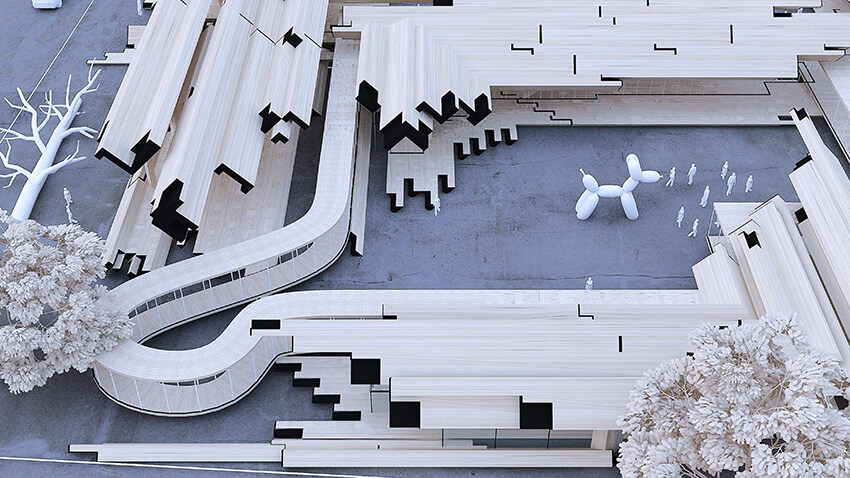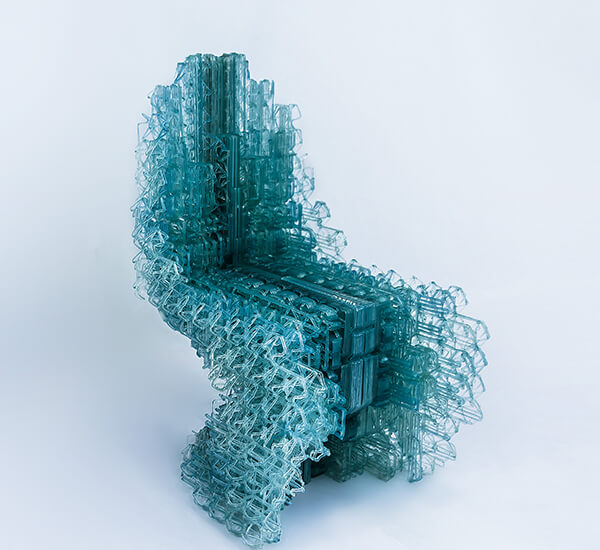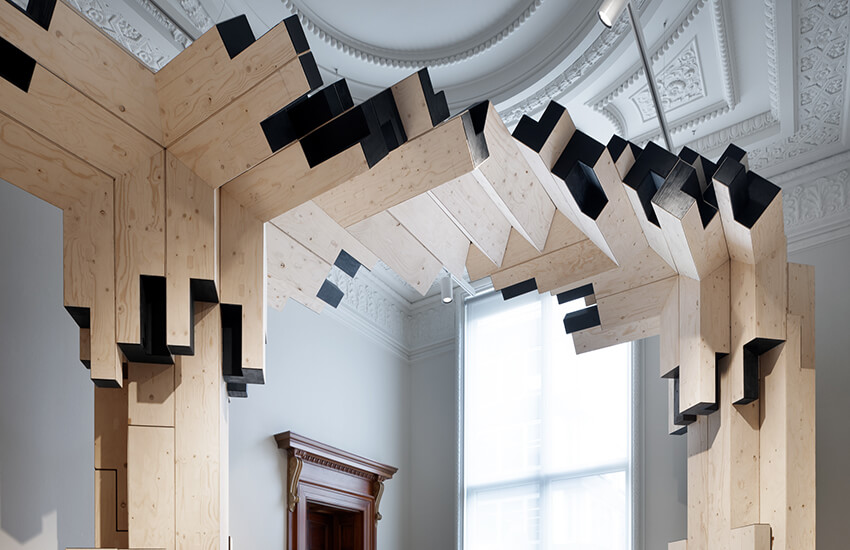Interview by Lidia Ratoi

What we talk about when we talk about architecture is what Gilles Retsin is actually doing. In the era of coding, robots, VR, AR and AI, the tricky part is that we are still physical beings living in a physical world, and we need to accommodate that. We also happen to be subjective creatures, longing for beauty and comfort, but it also happens that there are a few billions of us so we need to build something that is sustainable, feasible and efficient.
In this impossible juxtaposition of factors, we find Gilles Retsin. Program Director of the B.Pro Architectural Design (AD) within Bartlett School of Architecture, founder of Gilles Retsin studio and co-founder of SoftKill Design, Installation Programme Curator for the Tallinn Architecture Biennale, invited professor at Texas A&M University, and worldwide showcased, he is rephrasing how we view architecture, considering it to be birthed from module to whole, rather than in reverse.
Rather than using the digital to simply recreate the same kind of architectural processes we have used throughout history, Retsin advocates for a new way of using the digital, which is based on discrete elements, as opposed to the continuous. However, he does have a retro-future approach in the sense that he aims to reinstate the architect to its initial stance – that of a generalist. In his vision, the architect is capable of having a working understanding of all that the field requires – from traditional elements such as structure and functionality to advanced digital modelling and robotic fabrication. All this, under the aegis of beauty.
The discrete elements which he has been working with, from high res to low res, have triggered an entirely new aesthetic within architecture. In an era of man caving to software and tools, Gilles has raged against the machine and is taking control of each and every decision that comes within the architectural paradigm. However, he is taking full advantage of the technology he succeeded in mastering – from the work he is doing with Manuel Jimenez Garcia and Vicente Soler with robotic fabrication to his use of Microsoft Hololens in an AR-conducted construction site for the Imaginary Landscapes pavilion; it is hard to imagine a contemporary tool that has not been experimented with by Retsin.
Transitioning from small scales, such as the Mickey Matter project done within the Bartlett studio, to pavilions, such as the winning entry for the 2017 Tallinn Architecture Biennale, to large scale architecture, as in earlier work such as the proposal for the Guggenheim Helsinki Museum or in the infamous Budapest New National Gallery, the philosophy of Retsin speaks the same language – that of discrete elements.
Gilles Retsin overcomes the timidity with which computational design has taken over the architecture world – rather than trying to rationalize it as a tool, Retsin takes control of his own qualities as an architect. He does not shy away from having a style, from discussing aesthetics or from advocating the importance of our own minds, taste, skills and humanity in the design process.
Showcasing rockstar abilities to change, or at least challenging architecture in the form that it exists, the works of Retsin are no less than a love letter to the field that he is redefining. Each of his projects, from the Protohouse to Diamonds, has proved his ideology to be feasible, fabricable, and, most important – beautiful.




For computational designers and architects, your work is characterized by discrete elements in an ongoing battle of re-thinking architecture as something different than a “whole” and for pioneering the second wave of digital architects, striving to create something purely digital in entirety. But for our readers who are less familiar with your work, how would you describe your design philosophy?
In a very simple way, you could say that I am primarily interested in shortcutting the production of architecture to increase access. I think we can build amazing and inspiring spaces much more quicker and with lesser means. There are many ways to do this; my approach looks at discreteness, prefabrication and modularity. However, rather than the well-known, often despised, repetitive apartment blocks of the sixties and seventies, we can now create really much more varied and interesting structures.
The combination of computation with parts, elements and modularity – a.k.a the discrete – has deep economic and logistic implications but, at the same time, also poses a challenging aesthetic and creative question. As architects, we have traditionally been trained to think from the whole down to the parts. In this case, we need to learn how to design without a predefined whole. I am really interested in the qualities of this process.
Architecture becomes something primitive, monolithic and raw – with a whole new set of aesthetics and experiences associated with this. There is also a kind of bluntness about it that I like: it is what it is. There is no cladding, no little tricks or visual cheats. It’s just a bunch of parts – yet all together, they produce really new and unseen qualities. We’re only just at the beginning of figuring out what this discrete architecture, these assemblies, can do for us in terms of spatiality, experience etc.
In your work, the overall figure is not particularly important, but rather the organization of the parts, an approach which first came to life in your Budapest New National Gallery proposal. These ideas you have previously linked to various influences, from designing something that is buildable to Object-Oriented Eclecticism. In return, this birthed the now-famous Gilles Retsin style. How do you see it evolving, and what are your thoughts on the future of your design ideology?
I think the main evolution now is towards more radical application. The work started out initially as a very radical theoretical proposition, whereas now I am confronted much more with questions of building and materialisation. For a while, this has led to the work reducing in resolution and being a bit more minimal. However, currently, we are also looking back at some of the more intricate work and trying to make that more accessible and buildable.
The big challenge is further to develop the two main threads of the work – on the one hand, the social and economic arguments and on the other hand, the architectural and aesthetic consequences of discreteness. I have a huge backlog of ideas which haven’t been tested yet, a pile of sketchbooks and folders with 3D models. But there is no hurry in trying these out. I think you need to be very careful as an architect not to burn all your ideas at once. In the end, architecture really is a marathon where it is better to go quite slow and deep into an idea instead of racing through your work and getting tired.
Speaking of style, inevitably, your approach led to a specific aesthetic quality. After a long period of architecture being afraid to talk about aesthetics and computational design trying to establish itself and over-justifying each gesture with terms such as “optimization” or “efficiency”, the biggest event in the field, the Tallinn Architecture Biennale of 2019, where you are Installation Programme curator, is titled “Beauty Matters: The Resurgence of Beauty”. What do you think about the idea of aesthetic quality in architecture, and how do you define beauty?
Beauty and aesthetics are incredibly important for architecture, and it’s definitely something that has always driven my work – although I have never explicitly argued for it. So in this sense, Yael Reissner’s work for the Tallinn Architecture Biennale really pushed me to start to use the term more openly. I think a deep aesthetic interest doesn’t contradict interests in computation, production chains, politics, or social issues.
There is often this kind of idea that you have to be either concerned with social issues or you have to be into aesthetics and form. We have to learn to think about all those things together again – they are absolutely not opposed to each other. The kind of pure logistical approach to architecture – be it by only thinking about optimisation and efficiency or by only thinking about social issues is too reductive.
Architecture is really holistic and generalist; you can’t just isolate one part and get really good at that and then think that when you design a building, it will be good because you are so good in this one aspect. It won’t – the building will probably be deeply uninteresting. If you develop some really smart things for one aspect of architecture, it may just turn out to be meaningless once you try to use it for a building. But to go back to the question, I find it very interesting how lots of buildings that are designed are less beautiful than the ones that are not deliberately designed.
This was already the case with Le Corbusier when he wrote about the beauty of concrete silos and engineered structures. These engineers were not trying to make those beautiful, but they just happened to be really beautiful. Similarly, most buildings are still beautiful when they are in construction but ugly once finished. And abandoned parking garages and factories often make better museums than the ones that are deliberately designed. So beauty in architecture is super important but really hard to catch.
A question that has been surfacing is that architecture is becoming only a product of software – we are, to a worrying degree, able to tell in which software a building was generated and translate aesthetics through computational particularities. However, your style seems to have escaped this posture, and ironically, you have been described as famous for using processing to generate straight lines. Do you think it is this exact kind of rebellious attitude of going against what the software “wants” that has helped shaped your identity as an architect?
We shape our tools but are also shaped by our tools at the same time – we operate in resonance with them. I never liked an indexical relation to software, perhaps the Voronoi as the most famous example. I think I just started to do things to escape the indexicality, like running an agent system constrained to 45 and 90-degree angles. This is a very simple move, but something that didn’t exist in nature before, so you remove that indexicality.
I think in the meanwhile, as a community of designers, we have overcome a lot of these initial indexical obsessions; in the Bartlett B-Pro program, for example, we can now really see a whole body of work that is not easily traced back to a certain operation. Fundamentally, this problem of indexical algorithms comes from a lack of dealing with other constraints such as materiality, etc. Often algorithms are just immediately turned into supposed buildings – without any more translation. What we should really be doing is computing architecture, not applying predefined algorithms to architecture.
I am really interested in opening up a space for authorship and design intent within computation and automation. There is not one objective, universal solution to the problems we are looking into – as the Modernists would have argued for. So even though, together with a large community of people, I put a lot of work into establishing the Discrete as a paradigm, as something shared, I think people need to take their own authorial positions within that.
The aesthetics and the kind of architecture I propose is very personal; it’s my reaction to ideas of modularity and discreteness. However, there are many other possible ways of dealing with the same base assumptions. People often misunderstand this and don’t seem to be able to distinguish between what aspects of my work are personal authorship and what is an abstract base paradigm that we can all work on.
Using the idea of pixels in architecture has taken various postures. Some, such as Casey Rehm, take an almost cinematographic approach to it, while others, such as MVRDV, take a literal approach to it. However, you treat 3-dimensional architecture in terms of resolution as one would treat an image and highlight the potential of both low and high-res. Which idea was first – one of the particular elements, or that of the variable level of continuity, or did they seamlessly blend together from the beginning?
It first started with the elements at a relatively high resolution and then gradually decreased in scale. This is also a conceptual exploration, trying to understand what this resolution means, if we really need it, and how it operates. The main thing is the redefinition of the part, the idea that a part is no longer a mono-functional type but more of a generic building block. It only gains a particular functionality after it is assembled.
The parts don’t derive their function from the whole but construct the whole. I am currently very interested in large-scale parts, delivering low-resolution buildings. Large parts have a lot of constructive advantages; you can build very quickly, you don’t have that many joints, and structurally it makes more sense as well.
Architecturally they also have a lot of value. When parts are very small, they are not really autonomous; you will inevitably read the larger whole or pattern more than these elements. I am not interested in rooms as parts or entire chunks of buildings as parts. I am also not interested in bricks or particles as parts. I am interested in buildings where every part is really autonomous, the scale between the room and the brick. This is something really strange and fresh in architecture.
These kinds of qualities didn’t really exist before in architecture, although some primitive or vernacular buildings come close – like the log cabin where the logs remain visibly autonomous logs, yet construct a building. I like how computation and automation ultimately result in something raw and primitive, something existential – rather than a glossy sci-fi-like environment. I like how Antoine Picon has framed this as “ architecture is probably the continuous evolution of the Primitive Hut”.
For most architects dealing with digital fabrication, the machine becomes a sort of form-generator – the capability of the tool and the material heavily influence the overall design. While it is obvious that in your work, mechanic logic is optimized, you use robots more as “workers”, which can bring to life a certain design idea and are being taken advantage of, rather than shape-givers. How do you personally view robotic fabrication, and how do you approach these sorts of projects?
I think architects have to a certain degree, misunderstood digital fabrication. Architects have indeed thought about robots as some kind of metaphysical exercise, as a form of digital craft. While this work is often very interesting, poetic and beautiful, it’s also a tricky position. We shouldn’t forget that robots are ultimately tools to create more efficient production processes by removing human labour. It’s deeply political. I think, as a community, we have not spent enough time thinking about digital machines in architecture as a form of “automation”, the blunt attempt to produce more efficiently.
Using the term Automation helps us to situate our work with robots in the world as something with political and social consequences. We can then begin to think about what robots can deliver, and how digital machines can make building more accessible, quicker, and versatile. How they impact how we dwell, live and own. We have done that once before in history – when the modernist project actively took on board Mechanisation.
They understood that mechanised, rational production could enable a project of creating better housing and public facilities for everyone while all along celebrating new radical aesthetics, qualities and modes of life. With my colleagues at the UCL Design Computation Lab, we have recently put together a book called “Robotic Building – Architecture in the Age of Automation” that attempts to explain this paradigm shift and its potential.
Generally, in the computational architecture field, there is a division between the makers and the digitalists between large-scale research and small-scale. However, you successfully balance all these entities, juggling digital fabrication, AR, digital research, architectural projects and pavilions or product design. Is this a result of your very distinct style, which naturally influences all branches of design, or is it a conscious effort to push boundaries in all fields?
This goes back to what I mentioned before about architecture being something for generalists. I genuinely believe you have to do a bit of everything at once to achieve something meaningful. I am not necessarily trying to push any boundaries in a particular field by itself. Most of what I do is not that interesting or novel per se when you isolate one aspect. The novelty and quality are in being able to play out all of those things at the same time. Architecture is really allergic to specialists.
Perhaps one of the reasons we are constructing so many terrible buildings these days is because specialism has increased so much in our profession. There are specialist courses in universities, creating specialist consultants and specialist architects. In the end, no one knows anymore how to put a building together; you need a whole committee around the table. I do believe in collaboration and love to work with brilliant engineers or climate consultants, but we need to be careful not to fragment our profession into tiny little pieces – we would lose the little power that we still have.
In principle, digital tools should really allow us to become generalists again, to design, calculate and build our own buildings – overseeing the whole process. I think the most inspiring architects today are those who are making their hands dirty, designing and fabricating their buildings themselves. That’s something really positive that the whole digital design and fabrication education has delivered over the past couple of years – people who want to build again. People who want to do everything.
What is your chief enemy of creativity?
I think the overabundance of images on platforms like Instagram and Pinterest can be really stifling for creativity. It somehow flattens out all the work, be it of very high or very low quality; it doesn’t seem to matter. I think as a designer, you need to be very careful with too much inspiration and references. This being said, I do follow lots of architects on Instagram, but that’s just out of interest – not really as inspiration.
You couldn’t live without…
I am trying to use this question and the previous one to give some hidden advice. This question would probably have people answer things like “ I couldn’t live without architecture or my work etc.” I think it’s important to state that you could and that you actually need to make sure to cultivate enough other interests beyond architecture. If you don’t regularly read a good book, watch a good movie, or go to an exhibition – then you don’t have a lot to feed on and grow. If you want to be a good generalist architect, you also need to have a bit of general interest and time for those things. I
believe in taking your time with architecture; it’s not because you work the most that you are the best. Going a bit slow and being a bit lazy sometimes is not opposed to passion and devotion to what you do. And again – this is what the digital and automation can actually help us with, to do better things quicker and therefore have more time.






